U.S. Department of Transportation
Federal Highway Administration
1200 New Jersey Avenue, SE
Washington, DC 20590
202-366-4000
Federal Highway Administration Research and Technology
Coordinating, Developing, and Delivering Highway Transportation Innovations
|
R&T NOW This newsletter is an archived publication and may contain dated technical, contact, and link information. |
|
| Publication Number: Date: November/December 2018 |
Publication Date: November/December 2018
|
PDF files can be viewed with the Acrobat® Reader®
USDOT Plans Transportation’s Future with Automated Vehicles
The United States Department of Transportation (USDOT) announced new Federal guidance for automated vehicles. Elaine Chao, Secretary of Transportation, delivered remarks at the AV 3.0 Roll Out at DOT Headquarters on October 4, 2018, which coincided with the release of Preparing for the Future of Transportation: Automated Vehicles 3.0 (AV 3.0). AV 3.0 supports the safe, reliable, and cost-effective integration of automation into the Nation’s roads and highways.
The new guidance addresses safety and innovation by focusing on three areas: establishing guidance for automated vehicle development across all modes of transportation; clarifying policy and roles to help avoid conflicting regulations that could hamper innovation; and outlining a process for State and local agencies to work with USDOT to create a path toward automation.
AV 3.0 also outlines important issues that could potentially be impacted by automated vehicle technology, such as accessibility, cooperative automation and connectivity, and cybersecurity and privacy.
USDOT has established six principles that will ensure a clear and consistent Federal approach to shaping policy for automated vehicles. USDOT will (1) prioritize safety; (2) remain technology neutral; (3) modernize regulations; (4) encourage a consistent regulatory and operational environment; (5) prepare proactively for automation; and (6) protect and enhance the freedoms enjoyed by Americans.
USDOT will apply these principles to implementation strategies, which include engaging stakeholders and the public, providing test and operational best practices to stakeholders, supporting voluntary technical standards, conducting targeted research, and modernizing regulations.
AV 3.0 identifies the following considerations for State DOTs and metropolitan planning organizations, which will streamline the implementation of the Federal guidance:
USDOT intends for AV 3.0 to serve as the guide for the implementation of automation onto the Nation’s roads and highways. Public comments on Preparing for the Future of Transportation: Automated Vehicles 3.0 closed on December 3, 2018.
For more information, contact John Harding, 202–366–5665, john.harding@dot.gov.
TFHRC Welcomes New NRC Associates
In August, the newest class of NRC Associates began work at Turner-Fairbank Highway Research Center. Through the Exploratory Advanced Research (EAR) Program, the Federal Highway Administration (FHWA) participates in the NRC Research Associateship Program (RAP) by inviting postdoctoral researchers with appropriate backgrounds to investigate specific problems on a short-term basis across a wide range of topics and disciplines.
“The RAP benefits are two-fold,” says Dr. Hoda Azari, Nondestructive Evaluation (NDE) Research Program Manager at FHWA and an experienced NRC Associate adviser. “The fellows have the opportunity to work alongside some of the Nation's best highway engineers and research scientists; and, in return, FHWA benefits by the expected transfer of new science and technology to enhance the management of our Nation’s highway infrastructure assets.”
The new associates and their research projects are:
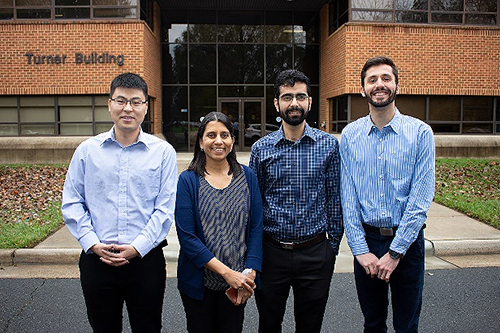
Source: FHWA
The new NRC Associates shown from left to right:
Chenhui Liu, Raka Goyal, Mohammadmehdi
Nikirashidi, and Pavle Bujanovic.
More information about the program can be found here along with a list of current opportunities. The EAR Program’s Research Associates Program 2016 booklet contains summary descriptions of some of the recent projects that NRC Associates have been involved in during their tenures at FHWA.
For more information, contact Jim Shurbutt, 202–493–3420, jim.shurbutt@dot.gov.
Research Leads to Improved Wildlife Monitoring
Transportation agencies monitor wildlife near highways to assess the design of under and overpass structures that allow wildlife to move while reducing conflicts with vehicles and improving highway safety and environmental stewardship. Traditionally, agencies would use remote camera systems (known as camera traps) that were checked manually and in person by transportation agency staff, who downloaded the collected data. This system meant data were sometimes weeks or months old by the time they were viewed, data could be lost because of equipment failure or poor siting, and data collection posed safety risks to workers.
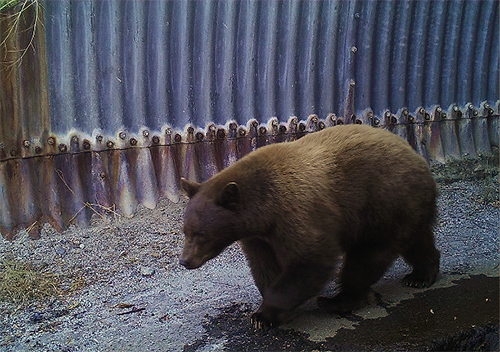
© 2018 UC Davis Road Ecology Center
A bear passes through a half-pipe culvert under I–80
in the Sierra Nevada Mountains.
Researchers working on an Exploratory Advanced Research (EAR) Program project titled “Remote, Wireless Camera Systems for Environmental Monitoring of Transportation Corridors” set out to overcome these obstacles. The researchers at the Road Ecology Center at the University of California, Davis, created Web-connected, wired, and wireless camera systems to collect wildlife data and transmit the output almost instantly on the Web via a wireless data transportation service.
In the first phase of the project, researchers investigated options for camera traps and a monitoring system using wired Internet connections, Wi-Fi®, or cellular technology. In the second phase, the researchers worked with the California Department of Transportation and other State transportation agencies to fine tune the camera system to meet the needs of States and develop an online database that agencies can use to collect, manage, analyze, and share the wildlife image files collected.
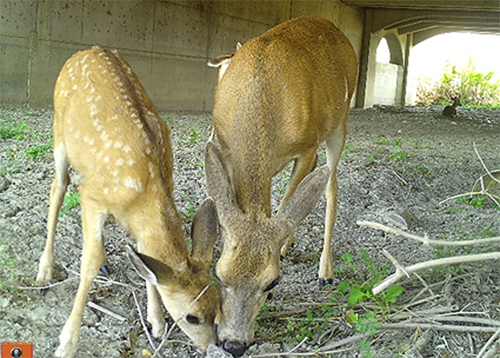
© 2018 UC Davis Road Ecology Center
A pair of deer under an I–680 multispan bridge in
the Bay Area in California that is part of a
multiagency collaboration to protect the nearby
creek bank for wildlife movement.
Continued work with the EAR Program in this area is underway to develop automated image analysis solutions to identify whether an image includes an animal and, if so, to identify the species, characteristics, and possibly its behavior based on body pose and movement.
For more information, see the fact sheet or contact Deidre Remley, 202–366–0524, deidre.remley@dot.gov.
Office of Operations R&D Keeps Traffic Flowing with Good CARMA
The Federal Highway Administration’s (FHWA) Office of Operations Research and Development deployed the Cooperative Automation Research Mobility Applications (CARMA) platform with the goal of improving transportation efficiency and safety. The platform specifically focuses on how infrastructure can help to move traffic more efficiently.
The CARMA platform enables Automated Driving Systems (ADS) to communicate with other vehicles and roadway infrastructure. The CARMA platform equips vehicles with the ability to interact and cooperate with infrastructure and other vehicles, enabling safer and more efficient transportation.
CARMA started in 2014 for the development and implementation of the initial proof of concept software platform, CARMA1. In 2018, the current version of CARMA, CARMA2, migrated to a Robot Operating System (ROS) architecture. CARMA2 was recently completed and is now available on GitHub, a software development platform. CARMA3 kicked off in August 2018 and will be developed in the open using agile software development.
The CARMA2 platform includes plug-ins that support the following cooperative driving tactics:
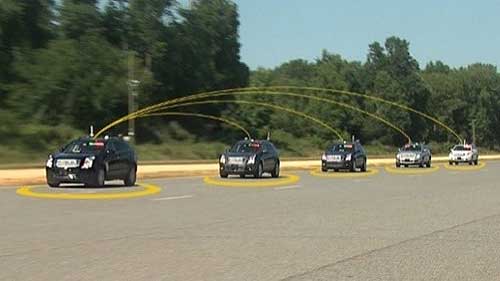
Source: FHWA
Vehicles testing CARMA’s capabilities.
For more information, contact Taylor Lochrane, 202–493–3293, taylor.lochrane@dot.gov.
FHWA Plans to Update the MUTCD
The Federal Highway Administration (FHWA) plans to update the Manual on Uniform Traffic Control Devices for Streets and Highways (MUTCD) in response to the United States Department of Transportation’s release of Preparing for the Future of Transportation: Automated Vehicles 3.0 (AV 3.0). AV 3.0 is the new Federal guidance for automated vehicles. The MUTCD is the national standard for all traffic control devices installed on streets, highways, bikeways, or private roads open to public travel.
FHWA will update technical provisions to reflect advances in technologies and operational practices, incorporate recent trends and innovations, and prepare the MUTCD for automated driving systems. The new edition of the MUTCD will propose to streamline processes and reduce burdens on State and local agencies by adopting many of the successful devices that have resulted from some of the 150 official experiments approved by FHWA, including congestion-reduction strategies and pedestrian safety enhancements. The new edition of the MUTCD will seek to allow more flexibility and innovation to improve travel for drivers, pedestrians, and bicyclists.
The first edition of the MUTCD was published in 1935 to establish uniform and easily recognizable traffic control features on streets and highways. The current edition was published in 2009 and revised in 2012.
As part of the process of updating the Manual, FHWA will seek input from the public, including State and local traffic engineers, traffic control device technicians, and other stakeholders through the rulemaking process.The proposed changes are expected to be released for public review and comment in Spring 2019.
For more information, contact Kevin Sylvester, 202–366–2161, kevin.sylvester@dot.gov.
Mohammed Yousuf Delivers Keynote Address at the Center for Advanced Transportation Mobility Symposium
Mohammed Yousuf, Accessible Transportation Technologies Research Initiative (ATTRI) Program Manager in FHWA’s Office of Operations Research and Development, delivered the keynote speech at the second annual Center for Advanced Transportation Mobility (CATM) Symposium in Blacksburg, VA, on November 5, 2018.
The symposium, hosted by the Virginia Tech Transportation Institute (VTTI), brings together researchers, faculty, staff, students, practitioners, and other transportation stakeholders to discuss and share the activities taking place within CATM. The symposium’s goal is to establish meaningful and productive collaborations that will enable further advancements within the transportation industry.
Mohammed’s address focused on the role of automation and enabling technology to bring innovative accessible transportation solutions to bear. He mentioned that the Department recognizes that automation and ATTRI technologies have the potential to improve our quality of life and enhance the mobility and independence of millions of Americans, especially older Americans and people with disabilities. Though focused on the needs of people with disabilities, these efforts will offer all Americans enhanced travel choices and accessibility at levels once only imagined.
ATTRI is a joint USDOT initiative, co-led by the Federal Highway Administration (FHWA); Federal Transit Administration (FTA); and Intelligent Transportation Systems Joint Program Office (ITS JPO); with support from the National Institute on Disability, Independent Living, and Rehabilitation Research (NIDILRR); and other Federal partners.
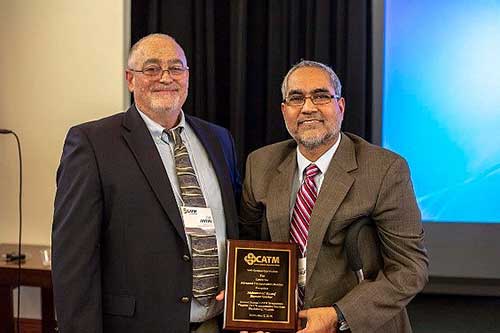
© 2018 VTTI
Mohammed Yousuf, right, receives a Keynote
Speaker plaque from Jon Antin, Director, Center for
Vulnerable Road User Safety at Virginia Tech
Transportation Institute.
The ATTRI Program is leading efforts to develop and implement transformative applications to improve mobility options for all travelers, particularly those with disabilities. ATTRI research focuses on removing barriers to transportation for people with visual, hearing, cognitive, and mobility disabilities.
For more information, contact Mohammed Yousuf, 202–493–3199, mohammed.yousuf@dot.gov.
Office of Safety Publishes Report on Connected and Automated Vehicles’ Roles in Roadway Departures
The Federal Highway Administration’s (FHWA’s) Office of Safety Research and Development recently published a report that addresses the effects and opportunities of widescale adaptation of connected vehicle (CV) and automated vehicle (AV) technologies on the Nation’s roads.
The primary purpose of the report, “Infrastructure Initiatives to Apply Connected- and Automated-Vehicle Technology to Roadway Departures,” is to explore the role of highway infrastructure in enabling connected and automated technologies to reduce the number and severity of roadway departure crashes.
The project produced initiatives that FHWA may use to support the deployment of CV and AV technologies in ways that will address roadway departure crashes. The initiatives were developed from a literature review and consultation with technology developers, vehicle manufacturers, State and local departments of transportation, and infrastructure officials. This report is intended for traffic engineers, highway designers and planners, and other transportation professionals, to acquaint them with potential infrastructure changes that could accommodate these emerging vehicle technologies.
Connected vehicles and automated vehicles are complementary technologies with the potential to dramatically reduce roadway departure crashes.
The full report can be viewed here. For more information, contact Abdul Zineddin, 202–493–3288, abdul.zineddin@dot.gov.
FHWA Hosts Safety Analysis Webinar and Releases New Interactive Highway Safety Design Model
The Federal Highway Administration held a Data-Driven Safety Analysis (DDSA) webinar on November 1, 2018, to introduce the new release of the Interactive Highway Safety Design Model (IHSDM) 2018 – New Enhancements Support Data-Driven Safety Analysis. The webinar provided an overview of the new features, and explored how the IHSDM Economic Analyses (EA) Tool can be used to conduct economic analyses within IHSDM using Crash Prediction Module (CPM) results. The IHSDM is a suite of safety analysis tools that are used to evaluate the safety and operational effects of project-level geometric design decisions on highways.
The IHSDM CPMserves as a faithful implementation of the Highway Safety Manual (HSM) Predictive Methods (Part C) for two-lane rural highways, multilane rural highways, urban and suburban arterials, freeways, ramps, and interchanges. The complete IHSDM suite consists of six modules.
There are several new elements to the IHSDM 2018 Release:
To obtain the 2018 release, new IHSDM users can visit the “Download Registration” page and follow the instructions. Registered IHSDM users can use the IHSDM username and previously assigned password to access and download the new release. If the user has an earlier version of IHSDM installed, a “call home” feature will remind users to update to the latest version.
For more information, contact Abdul Zineddin, 202–493–3288, abdul.zineddin@dot.gov.
FHWA’s 2019–2022 Strategic Plan Focuses on Safety and Innovation
The Federal Highway Administration (FHWA) has released a Fiscal Year (FY) 2019–2022 Strategic Plan. The Strategic Plan aligns FHWA efforts with the four United States Department of Transportation strategic goals of safety, infrastructure, innovation, and accountability. To frame this effort, Agency leadership agreed on a new mission statement and six FHWA-specific strategic objectives that are consistent with the direction outlined in the Department’s Strategic Plan.
FHWA’s Strategic Plan describes key programs, initiatives, and performance measures associated with each of the FHWA strategic goals and objectives. With a focus on safety and innovation, FHWA seeks to reduce transportation-related deaths and serious injuries on the Nation’s roads and highways, invest in infrastructure to ensure mobility and accessibility, lead in the development and deployment of innovative practices and technologies, and serve the Nation with reduced regulatory burden and greater efficiency.
FHWA employees, contractors, partners, and stakeholders are encouraged to read the Strategic Plan and send comments and questions to FHWAStrategicPlan@dot.gov.
FHWA Releases Request for Nominations for FAST Act Designation of Alternative Fuel Corridors
Under Section 1413 of the Fixing America’s Surface Transportation Act (the FAST Act – passed in December 2015), the United States Department of Transportation (USDOT) was required to designate national corridors for electric vehicles and hydrogen, propane, and natural gas fueling (Compressed Natural Gas (CNG) and Liquefied Natural Gas (LNG)) infrastructure in strategic locations along major highways to improve the mobility of alternative fuel vehicles.
On October 5, 2018, the Federal Highway Administration (FHWA) released the third Request for Nominations. Any State or local agency is invited to nominate an alternative fuel corridor(s) for designation. An eligible corridor is an Interstate highway (e.g. I–10, I–80, I–95, etc.). If a non-Interstate highway on the National Highway System is nominated, then a compelling case should be made as to why it should be considered for designation. The following Geographic Information System (GIS) Shapefile information shall be submitted, along with the narrative portion, for each designation proposal.
Applicants should not include alternative fuel station information in the Shapefile; this will be completed by the National Renewable Energy Laboratory and FHWA during the analysis process.
Submit only the following centerline corridor information:
To submit nominations and Shapefiles, email Sara Secunda at sara.secunda@dot.gov; instructions will be provided on how to upload these files. The deadline for this solicitation is close of business Thursday, January 31, 2019.
For more information on the Alternative Fuels Corridor Program, visit https://www.fhwa.dot.gov/environment/alternative_fuel_corridors/.
FHWA Research and Technology Evaluation: Managing Risk in Rapid Renewal Projects
FHWA-HRT-18-045
https://www.fhwa.dot.gov/publications/research/randt/evaluations/18045/18045.pdf
Evaluation Report: Agent-Based Modeling and Simulation
FHWA-HRT-18-042
https://www.fhwa.dot.gov/publications/research/general/18042/index.cfm
Infrastructure Initiatives to Apply Connected- and Automated-Vehicle Technology to Roadway Departures
FHWA-HRT-18-035
https://www.fhwa.dot.gov/publications/research/safety/18035/index.cfm
Evaluation Summary: SHRP2 Traffic Incident Management Responder Training Program
FHWA-HRT-18-038
https://www.fhwa.dot.gov/publications/research/randt/evaluations/18038/index.cfm
Public Roads—Winter 2019
Exchanging Solutions Across the Globe; Recruiting Tomorrow’s Workforce; Toward Self-Diagnosing Bridges; Renewable Roadsides; Getting Connected in Wyoming
The issue will be available online via https://www.fhwa.dot.gov/publications/publicroads/19winter/index.cfm.
For more information, contact Lisa Shuler, lisa.a.shuler@dot.gov.
Innovator —November/December 2018
This issue includes: Changing Hydraulic Modeling; Colorado, Delaware, and Texas Take Home STIC Excellence Awards; States Make Innovations Everyday Practice; FHWA Awards
The issue is available online via https://www.fhwa.dot.gov/innovation/innovator/issue69/3dIssue/.
Turner-Fairbank Highway Research Center: https://highways.dot.gov/research/
Resource Center: www.fhwa.dot.gov/resourcecenter/
National Highway Institute: www.nhi.fhwa.dot.gov/home.aspx
Please forward this newsletter to others you think might find it interesting and/or useful.
Suggestions may be submitted to: FHWA_Now@fhwa.dot.gov.